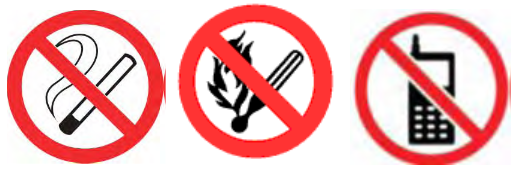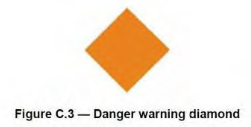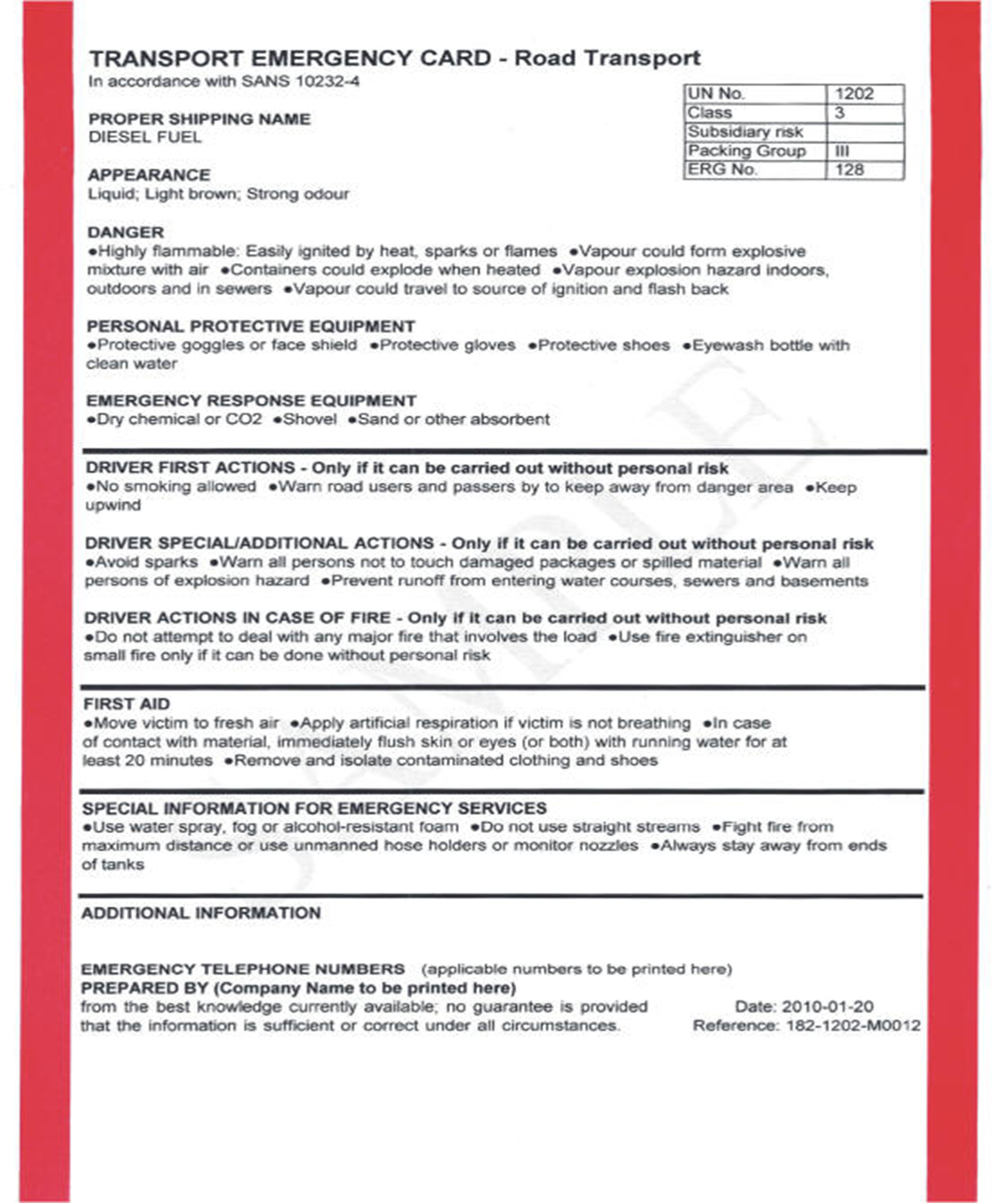In accordance with the South African Road Traffic Act (Act 93 of 1996) Chapter V and Chapter VIII, all vehicles used to transport any listed Dangerous Goods over the specified Exempt Quantities (Table C1 - SANS 10231) must comply with:
- SANS 10232-1:2007 Edition 3 Transport of dangerous goods - “Emergency information systems Part 1: Emergency Information System for Road Transport”.
Three regular-size dangerous goods placards shall be affixed to each cargo containment area of a rigid vehicle, semi-trailer or trailer; one at the rear and one on either side of the vehicle, so as to be clearly visible from the roadside. Vehicles with GVM of less than 3,500kg may be fitted with reduced-size placards where space does not allow the fitting of a regular-size placard.
A regular-size danger warning diamond shall be so affixed to the front of a vehicle or a truck tractor as to be clearly visible from the front. Vehicles with a GVM of less than 3,500kg may be fitted with a reduced-size danger warning diamond where space does not allow the fitment of a regular-size danger warning diamond. A danger warning diamond shall be a square with each side of length 250mm, set with one of its diagonals vertically. A reduced-size diamond shall be a square with each side of length 100mm, set with one of its diagonals vertically. The colour of the diamond shall be orange, and its design shall comply with the requirements given in C.3 of SANS 10232-1.

The full placard, including the 10 mm black border shall be clearly visible from the roadside, whether directly fixed on the vehicle, or supported by means of a permanently fixed frame. The placard shall be clean, legible and not defaced at all times.
Freight containers that are being transported by road as part of a journey that includes movement by sea freight or across borders, shall carry split placards that consist of the appropriate hazard class and subsidiary risk diamonds and goods identification rectangle affixed to either side and each end of the container so that they are clearly visible from both the rear and the roadside during transport and also meet the requirements of the IMDG regulations.
Vehicles that transport freight containers that are placarded in accordance with this part of SANS 10232 require only a danger warning diamond in addition to the required documentation in the designated space.
A freight container shall have split placards that consist of a goods identification rectangle, a hazard class diamond, or a mixed load diamond and subsidiary risk diamond(s).
Dangerous Goods Signage shall be made of suitable material (ABS plastic or Chromadek Steel) sufficiently rigid to prevent any distortion when the placard is exposed to forces encountered during transportation, as prescribed in SANS 10232-1.
The signage will indicate the following:
i. Dangerous Goods Placard: 700 x 400 single hazard, (for Mixed Load, single load and low hazard placarding).

ii. 290mm x 290mm or 190mm x 190mm - No Smoking, No Open Flame and No Cellphone decals, as per Municipal Bye-Laws.

iii. Dangerous goods that are transported at a temperature in excess of 100 °C (in the case of liquids) or 240 °C (in the case of solids)shall have three elevated temperature warning triangles attached to the cargo unit, one on either side and one on the rear of the unit, so as to be clearly visible from the roadside.

iv. The danger warning diamond shall be a square with each side of length 250 mm, set at an angle of 45° (diamond shaped). The reduced-size danger warning diamond shall be a square with each side of length 100 mm, set at an angle of 45° (diamond shaped). The colour shall be orange.

Tremcards
A Tremcard or a Transport Emergency Card as it is also known as is a document that is used when transporting dangerous goods. The Tremcard contains important safety information about the vehicle`s load. In an emergency scenario, the driver of the vehicle or rescue personnel can refer to the Tremcard to determine what dangerous goods are being transported and how the load should be treated. If there are different types of dangerous goods being transported on the same vehicle, then a Tremcard will be required for each type of dangerous item.
According to SANS 10232, a Tremcard should be an A4-sized document with thick red borders. This is to identify it quickly in an emergency. It has to be located in the cab of the vehicle when the vehicle is carrying a dangerous load.

Dangerous goods declaration
Document(s) prepared by a consignor or shipper to certify that the dangerous goods being transported have been packaged, labelled, and declared in accordance with the standard international shipping regulations.